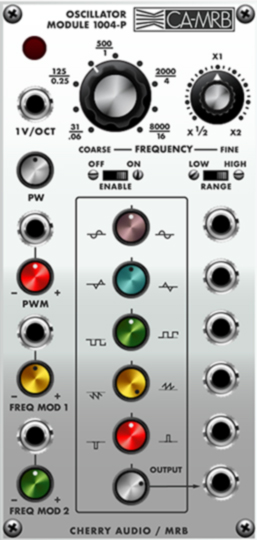
The 1004P is one of three primary oscillator modules. All three version are similar with slight control variations, but their underlying sound generation is essentially the same. They can be used in the audio range, or as low-frequency modulation sources.
Inputs, Outputs, and Controls
1V/Oct jack- Accepts a CV input for pitch. Typically this would come from the Pitch jack in the IO Panel CV Out section, or from a sequencer CV out.
Frequency / Coarse and Fine- The Coarse control sets the base frequency over a nine-octave range, in octave increments. The Fine control allows continuous fine pitch control and is configured as a "multiplier" with center position being nominal and a range of 1/2 pitch to the left or double the pitch to the right (i.e. +/- one octave).
Enable- Turns the oscillator on and off.
Range- Generally this will be set to Low when using as a mod source, or high for audio-range signals.
Waveform Volume- Sets the volume of the sine, triangle, square, ramp, and pulse waves in the master output. These do not affect volume of the individual wave out jacks.
Pulse Width (PW)- This sets the width or "duty-cycle" of the pulse wave (the very bottom waveform on the panel). It has no effect on any other waveform. Its default setting of 50% outputs a perfect square wave, rich in odd-order harmonics. Moving the knob left or right narrows its width as well as the thickness of sound until it almost disappears at its extremes.
PWM mod input jack and attenuator and PWM - You may have noticed that moving the Pulse Width knob back and forth creates a nifty sound; instead of wearing our your mouse hand, the PWM Mod input can be used in conjunction with an LFO, envelope generator, or other mod source to continuously vary the pulse width. The attenuator knob is bipolar; it allow positive (turn right) or inverted voltage control (turn left). It defaults to center zero position.
Frequency Mod 1 and 2 input jack and attenuator- This is used for externally modulating the oscillator frequency. It's useful for adding vibrato with an LFO, siren noises, envelope-controlled pitch sweeps, etc. The attenuator knob is bipolar; it allows positive (turn right) or inverted voltage control (turn left). It defaults to center zero position.
All mod inputs are exponential, that is, for a given mod input voltage, the mod amount increases as frequency increases. For example, if the base frequency is 1000 Hz, and a bipolar wave is applied to the mod CV input, the frequency falls to 500 Hz and rises to 2000 Hz. Because audio frequencies are inherently exponential in nature, the resulting frequency rises and falls exactly one octave.
Waveform volume knobs- Five waveforms are available: ramp, sawtooth, pulse, sine, and triangle. The corresponding volume knobs affect the waveform level at the master Output. The middle position is zero; dialing the knobs clockwise increases the positive waveform polarity output and dialing counterclockwise increases the volume of inverted waveform polarity output.
Waveform individual output jacks- These are output jacks for ramp, sawtooth, pulse, sine, and triangle waves. These can be used simultaneously, or in any combination. These are always at full amplitude and are unaffected by their corresponding volume knobs.
Master output knob and jack- Mix of all individual waveforms, dependent on corresponding volume knob settings and the silver master Output knob.